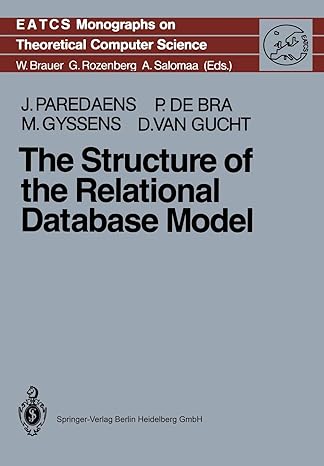Question
Draw an Entity-Relationship (ER) diagram that describes the following business environment. The Olympics wants to create an information system to keep track of its athletes,
Draw an Entity-Relationship (ER) diagram that describes the following business environment.
The Olympics wants to create an information system to keep track of its athletes, coaches, judges, and other associated information. With the exception of award and university data, which is historic, all of the information is only for the current Olympic games.
Athletes are, of course, the main focus of the Olympics information system. Each athlete is assigned a unique athlete number and the system also stores the athletes name and phone number. Coaches have a unique coach number plus their name and age. A coach can be responsible for many athletes but the system assumes that each athlete has only one, primary coach. The system also must record the country that each athlete represents. In addition to country name, the system must record the size and population of each country. An athlete can only represent one country while a country, of course, can have many athletes.
The Olympics wants to record the awards that each athlete has received in the past and the universities that each athlete has attended. Each award has a unique name and the system must also store the name of the organization responsible for the award and the award type (e.g. trophy, certificate, etc.) Since many of the awards are given annually, an award may have been given to many athletes. Similarly, an athlete may have won many awards and may even have won the same award in different years. For each instance that a particular athlete has won a particular award, the system must indicate the date of the award. Also, the Olympics wants to keep track of the universities that an athlete has attended. Each university is identified by its unique name and the system must also record its city and year it was founded. The system must also record the degree and year received for each degree awarded by a university to an athlete. Of course, some athletes may not have attended any universities.
Of course the Olympics is all about events. Each event has a unique event number, a name, category and the date of its final competition. Venues where events take place are identified by a unique venue number plus a name and type (e.g. swimming pool, track, etc.) Assume that an event takes place in only one venue while a venue can host many events. Events can have multiple judges and a judge can judge multiple events. Each judge has a unique judge number plus a name and age. Some judges supervise other judges. A particular judge will either be supervised by one other judge or be independent and have no supervisor. The system must also record each judges home country. Each athlete can participate in many events and, of course, each event has many athletes in it. The Olympics wants to keep track of the final or total score that each athlete got in each event and the medal that they received in the event, if any.
Step by Step Solution
There are 3 Steps involved in it
Step: 1

Get Instant Access to Expert-Tailored Solutions
See step-by-step solutions with expert insights and AI powered tools for academic success
Step: 2

Step: 3

Ace Your Homework with AI
Get the answers you need in no time with our AI-driven, step-by-step assistance
Get Started


